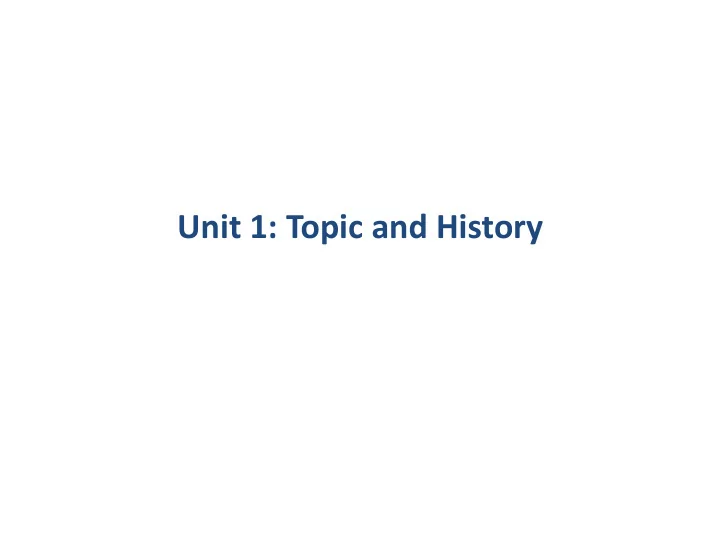

Unit 1: Topic and History
Learning goals – Unit 1 I. What is multicriteria optimization and decision analysis? II. How has this field developed? What were major historical steps? III. Examples of multicriteria optimization problems. What are criteria, search space, and constraints?
TOPIC OF MODA
Multicriteria Optimization and Decision Analysis • Definition: Multicriteria Decision Aiding (MCDA) (or: Multiattribute Decision Analysis) is a scientific field that studies evaluation of a finite number of alternatives based on multiple criteria. It provides methods to compare, evaluate, and rank solutions. • Definition: Multicriteria Optimization (MCO) (or: Multicriteria Design, Multicriteria Mathematical Programming) is a scientific field that studies search for optimal solutions given multiple criteria and constraints. Here, usually, the search space is very large and not all solutions can be inspected. • Definition: Multiobjective Decision Making (MCDM) deals with MCDA and MCO or combinations of these. • We use here the title : ” Multicriteria Optimization and Decision Analysis = MODA ” instead of MCDM in order to focus more on the algorithmically challenging optimization aspect.
HISTORICAL REMARKS
Early roots of MCDA • A very early reference relating to Multiple Criteria Decision Analysis algorithms can be traced to Benjamin Franklin (1706 1790) • He allegedly had a simple paper system for deciding important issues. • Take a sheet of paper. • On one side, write the arguments in favor of a decision; • on the other side, write the arguments against. • Strike out arguments on each side of the paper that are relatively of equal importance. • When all the arguments on one side are struck out, the side which has the remaining arguments is the side of the argument that should be supported. Supposedly Franklin used this in making important decisions. Benjamin Franklin, polymath and founding father of USA Source: http://www.mcdmsociety.org/facts.html 1706 – 1790
Development • Vilfredo Pareto (1848 – 1923), an Italian economist who used the concept of Pareto efficiency in his studies of economic efficiency and income distribution: • At the same time Francis Edgeworth defined ‘indifference curves’, the ‘core’ of an exchange economy, and the so- called ‘Edgeworth box’ based on a concept of local Pareto optimality for two criteria. • When Kuhn and Tucker formulated optimality conditions for nonlinear optimization with constraints in 1951, they also considered problems with multiple objectives. Vilfredo Pareto, Albert William Tucker Francis Edgeworth, Harold W. Kuhn Italian economist, British Economist, US-American Canadian 1848-1923 Mathematician Mathematician, 1924-2014 1905-1995 1951 Around 1900
Vilfredo Pareto ‘We will say that the members of a collectivity enjoy maximum economic satisfaction in a certain position when it is impossible to find a way of moving from that position very slightly in such a manner that the economic satisfaction enjoyed by each of the individuals of that collectivity increases … any small displacement in departing from that position necessarily has the effect of increasing the economic satisfaction which certain individuals enjoy, and decreasing that which others enjoy.’ Ehrgott, Matthias. "Vilfredo Pareto and multi- objective optimization." Optimization Stories, Journal der Deutschen Mathematiker- Vereiningung, Extra 21 (2012): 447-453. http://www.math.uiuc.edu/documenta/vol- ismp/63_ehrgott-matthias.pdf
Development Ralph Steuer, US American Economist • Ralph Keeney and Howard Raiffa published an important work in 1976. This book was instrumental in establishing the theory of multiattribute value theory (including utility theory) as a discipline. It became a standard reference and text for many generations of study of decision analysis and MCDM. • Ralph Steuer's professor, John Evans, suggested the topic of developing a multiple criteria simplex method to compute all efficient extreme points. Inspiration was drawn from earlier works of Karlin, Koopmans, and Geoffrion. Steuers ADBASE computer code for generating efficient points became important. (1986) Ralph Keeney Howard Raiffa Tjalling Koopmans US American *1924 1910-1985 Decision Analyst US American Dutch Economist Mathematician And Nobel Prize (economics) winner
Development • Kahnemann and Tversky studied the psychological aspects of decision making and pointed out (seemingly) irrational components in human decision making. • In the closely related field of game theory , John von Neumann and later John Nash studied decisions in games with conflicting parties. • Remark: Today, multiobjective game theory, is a topic at the intersection of MODA and game theory John Nash, John von US -American Neuman, Mathematican US -American (*1928) Mathematican Nobel Price (1903-1957) Economics Daniel Kahneman (u,*1934-) & Amos Tversky (l,1937- 1996), Israeli socio- psychologists, Nobel Price L
Development • Kaisa Miettinen published a book on Nonlinear Multiobjective Optimization (first edition 1999) which became a standard reference on deterministic methods for solving mathematical programming with multiple criteria. • Kalyanmoy Deb published a seminal book on Evolutionary Multicriteria Optimization (EMO), including NSGA-II algorithm. The work on NSGA-II became the most cited computer science paper 2000-2010. • Since then EMO is a very active field of research, not only in economics but also in (computer) science and engineering. • Recently, new term “Many - objective optimization” for problems with >> 3 objectives, e.g. urban planning, multidisciplinary design. Kalyanmoy Deb, Kaisa Miettinen, Indian Engineer Finnish Professor for & Computer Industrial Optimization Scientist President of MCDM Endowed Society Koening Chair, MSU Michigan
Recent advances: Lorentz Center Workshops: SIMCO 2013, SAMCO 2016 Indicator-based MCO Surrogate-Model Assisted MCO ~ Using Statistical Progress Measures ~ Costly Evaluations (Simulators)
Lorentz Center on Surrogate Assisted Multicriteria Optimization 2016 SAMCO Workshop Leiden March 2016
Development of MCDM field Johanna Bragge, Pekka Korhonen, Jyrki Wallenius and Hannele Wallenius:"Bibliometric Analysis of Multiple Criteria Decision Making/Multiattribute Utility Theory“: International Conference on MCDM in Auckland in January 2008.
MCDM Journals
Take home messages • The fields of multicriteria decision analysis and multicriteria optimization are distinguished by whether a small finite set is considered or search in a large search space. • The fields evolved in parallel, first in economics/operations research and later for other disciplines, especially engineering . and data science • In machine learning goals are to minimize error rates (false positives, false negatives) & model complexity. • In general, multicriteria optimization problems can be defined by the following components: search space , objectives , constraints
Recommend
More recommend